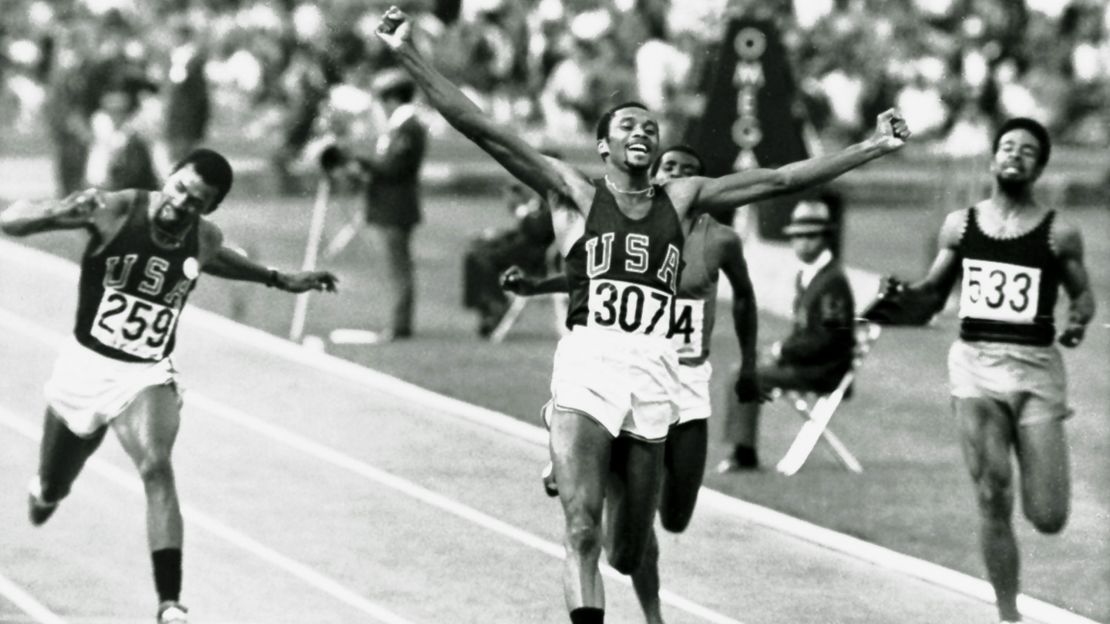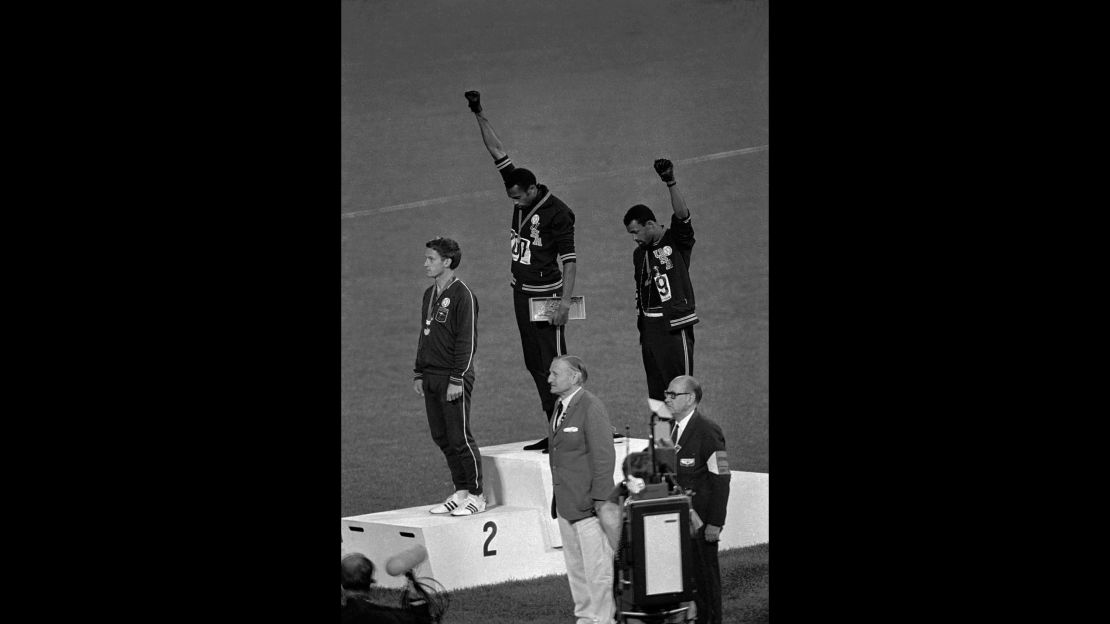Story highlights
Smith said he was dealing with a pulled muscle in his left leg on the day of the 200-meter final
He said the black glove on his right hand represented power and tranquility
On October 16, 1968, Tommie Smith and fellow American John Carlos won gold and bronze, respectively, at the Olympic Games in Mexico City. With a time of 19.83, Smith broke the world and Olympic record in the 200-meter dash.
But what the two African-American men did on the podium afterward has been talked about ever since. Each raised a black-glove-covered clenched fist in a stand for human rights. It was an iconic image from the turbulent ’60s.
Smith, now 72, sat down Monday with CNN in Lilburn, Georgia, an Atlanta suburb, to reflect on that historic day that happened almost 48 years ago. Below are portions of that interview.
On that day:
It was a culmination of a year and a half plus of decision making, academic movement, because I was still in college at San Jose State University. I was married with a son. That counted for something in terms of working, in terms of spending time at home and in terms of study.
On the plan before the race:
I did have an injured left leg, which was my power leg. I pulled that (muscle) in the prelims. I had to deal with that.
The decisions I made as far as the victory stand, or what I was gonna do – because it was decided by the athletes there would not be a boycott – each athlete will represent himself according to how he felt the country represented them or to show some sign of pride.
And this is why (I), one of the developers of the Olympic Project for Human Rights, this is what I had to do regardless of what any other athletes did. I had to make a decision because I was the the one of four (athletes) that started that program. And I had to end it because I was the only one of that four out on that victory stand (Another member, Lee Evans, later would win gold medals in the 400 meters and was a member of the 4 x 400-meter relay).
Going inside the race, from the gun to the finish line:
Just before we got into the blocks, I was standing back, with my hands on my hips, looking at the world’s fastest humans taking practice starts. But I couldn’t, because I was afraid that if I took a practice start, I might re-injure that muscle on the left side of my body and I wouldn’t be able to run the race at all.
So I decided to not warm up … and just get in the blocks. And be careful coming out the first 12 steps. …It felt pretty good.
Gun sounded – I was off. I looked in front and then I saw six people in front of me. Six people in front of me! I said, ‘Lord have mercy on me. Don’t send me back to the cotton field, just let me run.’
So when I came up out of the turn… the body kind of responded to the thoughts of, ‘OK, this is it son. All the work you did, all the Olympic Project for Human Rights talks you did, the speeches, going to class, getting your D’s in class because you were worried about this race, and you gonna fail it now – you can’t do that.’
So, I put on about 85 percent speed. I could feel it, the leg didn’t feel anything. So I said, ‘This is it.’ …So I pull the throttle for 12 steps, and I went by certain folks in the race and that kind of cured it for me because I went by I kept going until I threw my arms up in jubilation before (crossing the finish line).

Now that (celebration) was not planned. After all the things I had gone through to get there, then moving by that fast with the pulled groin area, I didn’t think it was necessary to do anything, but what my body told me to do, that was automatic, which was throw my arms up in jubilation. …Then I remembered, politically, a responsibility and a pride that I had to exude on the victory stand.
That was decided a few minutes before the race.
On what happened on the medal stand:
I decided to wear articles that represented why I must do what happened on that victory stand. The black socks represented poverty. The right hand in the air with the black glove represents power and tranquility – as much as I could muster at that particular time. Of course the head bow was a prayer. It was a prayer of hope, a prayer of saneness. The prayer of equality, all prayers. You send the right prayer you will get an answer.
The moment the victory stand happened, the moment national anthem started playing, the hand went up. … It did not represent Tommie Smith only, but it represented those who did not have a platform. It represented those who did not have a word. It represented those that had stories needed to be told.
And that pose gave them an opportunity along with the glorious sound of the national anthem to be jubilant in the ears of the world. And to be seen by the eyes of the world. Because it was worldwide issue, the Olympic Project for Human Rights, and it stands as that.
On the misunderstanding from people who took his actions to another place:
There was a lot of misunderstanding about what was happening because they had never seen that happen before especially by a black athlete in the eyes of the world. An athlete that hardly said anything about anybody before that particular stand. …

So the representation went further than just a victory stand. It represented a holistic idea of life, a holistic experience of equal rights, and that was in the back of my mind when the fist went to the sky in jubilation: a cry for freedom or a cry for hope. All of this was a culmination of the work that had gone in: the love, the experience of the academic experience, the experience of training physically and the jubilation of my doing what had to be done.
But it was done because I had no choice. To me it was a responsibility which I didn’t want to do, but I had to do it because I was the only one at that particular time who could do it standing from that particular platform.
On the immediate aftermath:
I knew because of what had just happened there would be an aftermath. I didn’t know how great, but for every action there is a reaction. Didn’t know what that action would be, so I did my military turns (Smith was in the ROTC) back to the left and another one back to the left again to get off the stand. …My hand went up one last time in the power hand struggle, which was the fist to the air. Why did that happen? Well because when I looked up in the stands, I saw faces of madness. Faces of discontent. Faces of ‘Why did you ruin your gold medal stand?’ And a lot of catcalls.
So I threw a fist up for the last time emphasizing the pride and the exuberance I had. All those sacrifices by doing this. It was over by then.
On what happened after he was kicked off the team and returned home:
Even my black brothers and sisters were rather shocked because of what had happened, because no one was told before I left that something would happen. …But it did, and many didn’t understand, number one, what it meant and, number two, it was gonna happen.
I came back to San Jose State amidst many cameras, many boos, no one at the airport to welcome us. …No job, couldn’t find a job, but I still had my rent to pay. I still had my light bill to pay. I still needed milk for Kevin, my oldest son now. On a 24-year-old, this is kind of tough.
Being a non-secular kid, I prayed. I said, ‘If this is meant for me, let it be.’ It helped me to move forward so I can continue doing my work. So I became an elementary school teacher, then a junior high school teacher then a junior college instructor then a four-year college instructor, got my master’s, my Ph.D., and I moved forward… into an adult life without competition.
On if he ever received any gratification:
People understood, in a small context of what happened, but I’m still explaining even now my feelings pushing up to that time.
I had to explain why I did it and taking it back to the system and continued to teach. That victory stand lives on because of the representation of time. And time changes. But that photograph will always be there to let you know no matter what you do, it’s gonna be there, because it represents you until you die. That’s a lifelong energy.
On what happened to that glove:
Had I known or had I been advised by anybody that that stand would have ended up being one of the most iconic stands in the history of man, I would have kept the gloves. I would have locked them up. I would of done something – maybe I would have worn two of them or something, who knows. But it wasn’t done for shape, form or fashion. It was done because of a need, done because of a pride in a system, a system of social change. …
In San Jose, it gets cold. So I wore them for warmth because I went to school at night and I needed something on my hands. I did use them.
I think I left them in the back of an old Chevy II. My son, who was about 6 months old, probably ate it something. I don’t know what happened to it. But it’s gone, wherever it is. Rest in peace.







